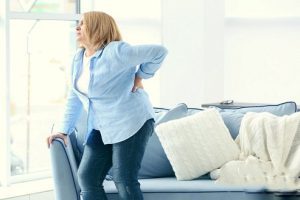The waist connects the upper and lower body to each other and bears the most weight pressure in the body. For this reason, injuries and back pain are very common, especially when bending, lifting or moving the body, and everyone experiences low back pain at least once. Low back pain is one of the most common reasons for being absent from work or seeing a doctor. Although low back pain is annoying and uncomfortable, it is usually not a serious problem and it is possible to prevent or reduce back pain by performing methods and factors. If you can not prevent low back pain, simple home remedies are usually possible to treat low back pain, and surgery is usually not needed to treat this common pain.

Signs and symptoms of low back pain
Signs and symptoms vary depending on the cause of low back pain. Back pain may be mild or vague or severe and severe. This pain can manifest itself in a small area of the lower back or the entire lower back. You may experience muscle cramps when you have low back pain. Low back pain can also cause foot problems such as pain, numbness or tingling in the foot. Most cases of low back pain are short-lived (acute) and go away after a few weeks. If you are under pressure, your low back pain may become long-term (chronic). Common symptoms of low back pain include:
♦ Muscle aches
♦ Striking or shooting pain
♦ Pain that stretches to the bottom of your foot
♦ Limiting flexibility or range of motion of the waist
♦ Inability to stand up straight

Causes of low back pain
Low back pain usually starts to appear for no apparent reason and it is not easy to find the cause. Factors that can cause low back pain include:
♦ Stretching of muscles or ligaments.
♦ Protruding or protruding disc and disc herniation.
♦ Arthritis
♦ age increasing
♦ Congenital spine problem
Other reasons include:
♦ sleep disorder
♦ Lifting and carrying heavy loads
♦ Improper mattress
People at risk for low back pain
Anyone, even children and adolescents, can have low back pain. Although overweight, lack of mobility, and poor posture are commonly thought to be the cause of low back pain, research into these factors has not yet reached a definite conclusion. One group that seems to be at higher risk for low back pain is people with mental health problems such as depression and anxiety, although the exact cause of the disease has not been determined.

How to treat low back pain
Most types of low back pain improve after a few weeks of rest and home remedies and the use of simple painkillers. A short rest in bed is appropriate, but sleeping more than a few days in bed can do more harm than good. Continue your daily activities as long as you can. Light activities such as walking and normal daily activities are usually easy and convenient. But if certain activities increase your pain, do not do it. If home remedies do not work after a few weeks or your pain is severe, you may need to see your doctor for strong medications or other treatments. Other treatments include:
Pharmacological treatment of low back pain
Your doctor will usually use painkillers such as acetaminophen or ibuprofen or naproxen. Take these medicines as prescribed by your doctor, as taking too much can have serious side effects. If your pain does not improve with regular painkillers, your doctor may use muscle relaxants.
Drugs such as codeine or hydrocodone may be prescribed for short periods of time.
Physiotherapy and exercise to treat low back pain
Physiotherapy is the basis of the treatment of low back pain. A professional physiotherapist can use a wide range of treatments, including heat therapy, ultrasound, electrical stimulation, and muscle release techniques on the muscles and soft tissues of the back of the body. A physiotherapist can teach you specific exercises that increase the flexibility and strength of your abdominal and back muscles. Doing these exercises regularly can help prevent back pain in the future.
Injections to treat low back pain
If other treatments do not work for you and your back pain does not go away or the pain gets to your legs and makes you disabled, your doctor may inject you with cortisone (an anti-inflammatory drug) around your spinal cord. Cortisone injections help reduce inflammation around nerve roots, but this relief lasts less than a few months.
Surgery to treat low back pain
Few people need surgery to treat low back pain. If you have severe back pain with a sprained leg or severe muscle weakness due to nerve strain, surgical treatment may be helpful. Otherwise, surgery is used only to treat congenital problems and bone structure that have not been adequately treated by other methods.
Treatment of low back pain with traditional or alternative medicine
Some types of traditional or alternative medicine can be used to treat low back pain, including:
♦ Acupuncture: An acupuncturist cannot improve pain and other symptoms of low back pain by inserting sterilized and stainless steel needles into specific areas of bad skin.
♦ Massage: If your back pain is due to muscle dryness or excessive pressure on the muscles, massage therapy may be able to help you.
♦ Yoga: Some types of yoga can help you reduce the severity of low back pain.

Prevention of low back pain
The following can help keep your back healthy and prevent future pain:
♦ exercise. Regular, low-intensity, aerobic exercise (exercises that do not put pressure on your waist) can increase your strength and endurance and help your muscles function better. Sports such as walking and swimming and the use of stationary bikes are good choices. Consult your doctor to find the most suitable exercise for you.
♦ Increase muscle strength and flexibility of your muscles. Abdominal and lumbar exercises (strengthening exercises) can strengthen the muscles in this area and turn these muscles into abdominal muscles that prevent high pressure on the back. To find the best and most suitable exercise for yourself, you should see a doctor or physiotherapist.
♦ Proper weight. Excessive pressure on your back due to obesity can cause your back pain. Losing weight can help you lose weight.
♦ Wear short heels.
♦ Do not try to lift things that are heavy for you.
♦ When sitting and standing, be careful to sit or stand up straight and keep your shoulders straight.
♦ Quit Smoking. According to a study, smokers are more likely to suffer from low back pain than non-smokers.
♦ Care in removing objects. Do not bend over to lift objects, but sit and lift them.
♦ Bed. You should use a mattress that keeps your spine straight while supporting the weight of your hips and shoulders.
♦ Driving. When driving, adjust the side mirrors so that you do not have to bend over to see them. Sit up straight and adjust your position so that the pedals are directly under your feet. If you drive for a long time, rest in the distance.
Medical site and health magazine im healthiest
